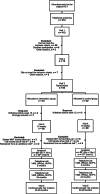A 2-year follow-up to a randomized controlled trial on resistance training in postmenopausal women: vasomotor symptoms, quality of life and cardiovascular risk markers
- PMID: 39272114
- PMCID: PMC11396825
- DOI: 10.1186/s12905-024-03351-1
A 2-year follow-up to a randomized controlled trial on resistance training in postmenopausal women: vasomotor symptoms, quality of life and cardiovascular risk markers
Abstract
Background: Most women experience vasomotor symptoms (VMS) during the menopausal transition. A 15-week resistance training intervention (RTI) significantly reduced moderate-to-severe VMS (MS-VMS) and improved health-related quality of life (HRQoL) and cardiovascular risk markers in postmenopausal women. Whether a short RTI could have long-term effects is unknown. We aimed to investigate whether there were intervention-dependent effects two years after a 15-week RTI on MS-VMS frequency, HRQoL, and cardiovascular risk markers in postmenopausal women.
Methods: This observational prospective cohort study is a follow-up to a randomized controlled trial (RCT) on a 15-week RTI in postmenopausal women (n = 57). The control group had unchanged low physical activity during these first 15 weeks. At the follow-up contact two years post-intervention, 35 women agreed to participate in an additional physical visit at the clinic with clinical testing, blood sampling, and magnetic resonance imaging, identical to the protocol at the baseline visit at the start of the RCT.
Results: Although all women showed reduced MS-VMS and increased moderate-to-vigorous physical activity (MVPA) over the 2-year follow-up compared to baseline, the groups from the original RCT (intervention group; IG, control group; CG) changed differently over time (p < 0.001 and p = 0.006, respectively) regarding MS-VMS. The IG maintained a significantly lower MS-VMS frequency than the CG at the 6-month follow-up. At the 2-year follow-up, there was no significant difference between the original RCT groups. No significant changes over time or differences between groups were found in HRQoL or cardiovascular risk markers. However, significant interactions between original RCT groups and time were found for visceral adipose tissue (p = 0.041), ferritin (p = 0.045), and testosterone (p = 0.010).
Conclusions: A 15-week resistance training intervention reduced MS-VMS frequency up to six months post-intervention compared to a CG, but the effect was not maintained after two years. The RTI did neither contribute to preserved improvements of cardiovascular risk markers nor improved HRQoL after two years compared to a CG.
Trial registration: Clinical trials.gov registered ID: NCT01987778, trial registration date 2013-11-19.
Keywords: Cardiovascular risk markers; Follow-up; Health-related quality of life; Hot flushes; Menopause; Midlife; Physical activity; Vasomotor symptoms.
© 2024. The Author(s).
Conflict of interest statement
The authors declare no competing interests.
Figures



Similar articles
-
Effects of resistance training on quality of life in postmenopausal women with vasomotor symptoms.Climacteric. 2022 Jun;25(3):264-270. doi: 10.1080/13697137.2021.1941849. Epub 2021 Jul 9. Climacteric. 2022. PMID: 34240669 Clinical Trial.
-
Postmenopausal women's experiences of a resistance training intervention against vasomotor symptoms: a qualitative study.BMC Womens Health. 2022 Jul 30;22(1):320. doi: 10.1186/s12905-022-01900-0. BMC Womens Health. 2022. PMID: 35907840 Free PMC article. Clinical Trial.
-
Resistance training reduced luteinising hormone levels in postmenopausal women in a substudy of a randomised controlled clinical trial: A clue to how resistance training reduced vasomotor symptoms.PLoS One. 2022 May 26;17(5):e0267613. doi: 10.1371/journal.pone.0267613. eCollection 2022. PLoS One. 2022. PMID: 35617333 Free PMC article. Clinical Trial.
-
Efficacy and safety of fezolinetant for vasomotor symptoms in postmenopausal women: A systematic review and meta-analysis of randomized controlled trials.Int J Gynaecol Obstet. 2024 Sep;166(3):969-983. doi: 10.1002/ijgo.15467. Epub 2024 Apr 2. Int J Gynaecol Obstet. 2024. PMID: 38563867
-
Vasomotor symptoms and risk of cardiovascular disease in peri- and postmenopausal women: A systematic review and meta-analysis.Maturitas. 2023 May;171:13-20. doi: 10.1016/j.maturitas.2023.02.004. Epub 2023 Mar 6. Maturitas. 2023. PMID: 36907116
References
-
- Berin E, Hammar M, Lindblom H, Lindh-Astrand L, Spetz Holm AC. Effects of resistance training on quality of life in postmenopausal women with vasomotor symptoms. Climacteric. 2021;25(3):264–70. - PubMed
Publication types
MeSH terms
Substances
Associated data
Grants and funding
LinkOut - more resources
Full Text Sources
Medical

